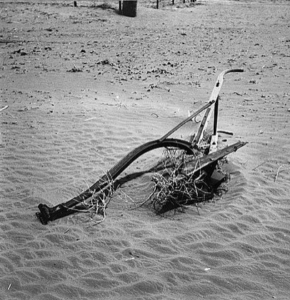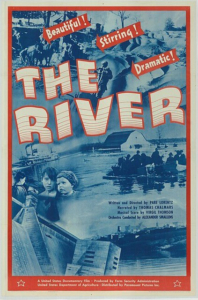Highlighting the nation’s problems during the Great Depression—and the federal government’s responses to those problems—was the job of the United States Film Service, established in 1938 as part of the New Deal’s Resettlement Administration, later renamed the Farm Security Administration (FSA). The Service’s inspiration was Pare Lorentz, a pioneer in the production of documentary films. Lorentz, a native of West Virginia, directed the U.S. Film Service from 1938 until 1940.
Lorentz’s first film, The Plow That Broke the Plains, about the Dust Bowl, was completed for the federal government in 1936. Hired to head the Film Service, Lorentz soon added The River, to his film credits. Completed in 1938 under the FSA, The River dealt with the disastrous floods along the Mississippi River and construction of Norris and Wheeler Dams.

The Plow That Broke the Plains
This classic film about the Dust Bowl has been one of the most widely studied documentaries. It was the first film to be placed in Congressional archives. Photo by Arthur Rothstein. Credit: Library of Congress.
Both films employed forceful narration and a dramatic soundtrack to expose how over-farming and soil erosion contributed to natural disasters and the New Deal’s response in the form of the Tennessee Valley Authority, Soil Conservation Service, Civilian Conservation Corps and other conservation initiatives. Lorentz used this tried-and-true style to direct or supervise three more documentary films for the Film Service.
The Fight for Life (1940), about a community health program to reduce maternal mortality, utilized professional actors. (Will Geer would later portray “Grandpa” in The Walton’s). It concludes with a tense scene in which a new mother pleads, “You won’t let me die, will you doctor?” (No spoilers here!)

Film Poster for "The River," directed by Lorentz and produced by the FSA.
The companion book to The River was nominated for a Pulitzer Prize for poetry. Credit, NARA.
The excellent, tightly focused Power and the Land (1940) follows a farming family as they go about their daily chores, pre- and post the Rural Electrification Administration that transformed remote areas of the country—no more oil lamps, just a flip of the switch!
The Land (1949) explores farming problems of the 1930s. It features a segment on Latino migrant workers and music by the National Youth Administration, but the narration is dull and the film falls flat.
The U.S. Film Service ended in the same way many other New Deal programs ended—it was defunded by national defense distractions and an increasingly hostile Congress.
After the New Deal, Lorentz created training films during World War II, worked as a film consultant and produced two notable documentaries: Nuremberg: Its Lesson for Today (1946) and Rural Co-op (1947), but struggled to raise money for other film projects. He died in 1992 at age 86.
His legacy lives on, aided by the Pare Lorentz Center at the FDR Presidential Library & Museum and the IDA Pare Lorentz Documentary Fund, which supports independent films about society’s most pressing problems.

Great Mississippi Flood, Arkansas City, Arkansas, 1927
Poor farming and timber practices led to one of the worst natural disasters in U.S. history. New Deal conservation efforts were featured in Lorentz’s films. Credit, NOAA.
Were Lorentz alive today—and running a U.S. Film Service—one could expect to see documentaries about such problems as global warming, ocean pollution, wildfires and America’s growing economic inequality playing at local movie theaters. Lorentz believed in the power of film to enlighten the electorate and inspire social change. (He also felt that Hollywood was spending too much time on the frivolous).
